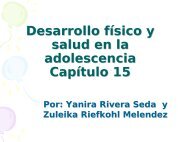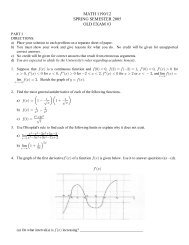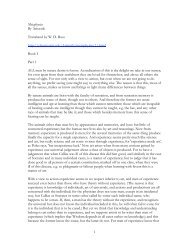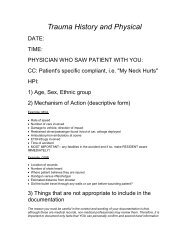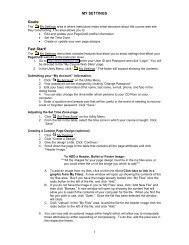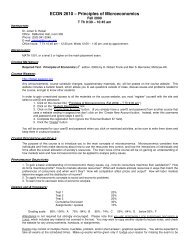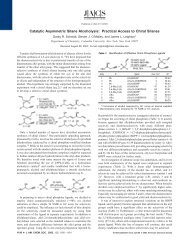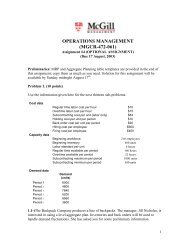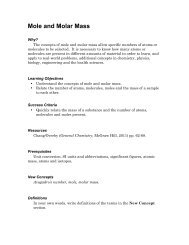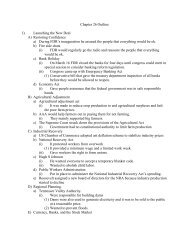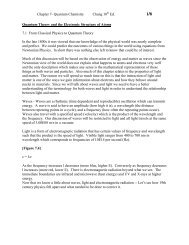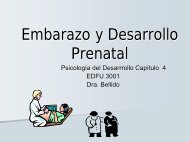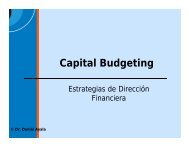Bunker Hill Community College General Chemistry I and ... - PageOut
Bunker Hill Community College General Chemistry I and ... - PageOut
Bunker Hill Community College General Chemistry I and ... - PageOut
You also want an ePaper? Increase the reach of your titles
YUMPU automatically turns print PDFs into web optimized ePapers that Google loves.
CHM 201 Syllabus SP11 1/16<br />
<strong>Bunker</strong> <strong>Hill</strong> <strong>Community</strong> <strong>College</strong><br />
<strong>General</strong> <strong>Chemistry</strong> I <strong>and</strong> Laboratory<br />
CHM 201-T1<br />
Course Syllabus<br />
Spring 2011
CHM 201 Syllabus SP11 2/16<br />
<strong>General</strong> <strong>Chemistry</strong> I <strong>and</strong> Laboratory<br />
CHM 201-T1<br />
Spring Session 2011<br />
Instructor: Dr. K. Stieglitz<br />
Office: B-336 Adjunct Faculty Room<br />
E-Mail: kastiegl@bhcc.mass.edu<br />
Internet Address: BHCC ONLINE or<br />
http://kstieglitz.pageout.net<br />
(electronic copies of syllabus, lecture notes <strong>and</strong><br />
HW assignments posted at this site)<br />
Office Hours: by appointment<br />
<strong>General</strong>: The best way to contact me is by email. In the event of an<br />
unexpected event (inclement weather, etc.) which would interfere with a<br />
scheduled exam or other major event, I will post a message on my web site or<br />
email <strong>and</strong> require you confirm receipt of the announcement. Do not assume<br />
class is canceled or an exam rescheduled unless you confirm it with me or the<br />
Dean’s office (Dean of Arts <strong>and</strong> Sciences).<br />
Course Description: A consideration of chemical principles<br />
including atomic structure <strong>and</strong> bonding, stoichiometry, gas laws, <strong>and</strong><br />
solution chemistry. This course is intended for students planning to<br />
transfer as science majors. Pre-allied health students should enroll<br />
in Chemical Science I <strong>and</strong> Lab (CHM 110).<br />
Prerequisite: MAT195 <strong>College</strong> Algebra<br />
<strong>General</strong> <strong>Chemistry</strong> I <strong>and</strong> II <strong>and</strong> Lab (CHM 201 <strong>and</strong> CHM 202) fulfills the<br />
chemistry requirement of biology, pharmacy, premed, prevet, engineering, or<br />
chemistry majors. It is expected that the student will go on to the second<br />
semester of this sequence <strong>General</strong> <strong>Chemistry</strong> II (CHM 202) or equivalent; CHM<br />
201 is not designed to be a one semester introductory course. This course is<br />
generally viewed as a science major introductory chemistry class. If your<br />
intended program of study is a physical science, pharmacy, pre-med/pre-vet, or<br />
engineering major this course is required. Laboratory work serves to reinforce<br />
concepts as well as introduce students to the scientific method, basic laboratory<br />
techniques, <strong>and</strong> the importance of safety in the laboratory environment.<br />
Students in most allied health programs <strong>and</strong> non-science majors filling a<br />
science elective should enroll in Chemical Science I (CHM 110). The CHM-201<br />
course is not designed to be a one-semester overview of general <strong>and</strong> inorganic<br />
chemistry but is the first semester of a two -semester sequence for science <strong>and</strong><br />
engineering majors. If there are questions regarding whether you need CHM 201<br />
or CHM 110 for your program of study, discuss this matter with the instructor or<br />
your academic advisor.
CHM 201 Syllabus SP11 3/16<br />
Student Commitment:<br />
The study of general chemistry for science, pharmacy, engineering <strong>and</strong><br />
pre-med/pre-vet majors is challenging but not impossible. In order to be<br />
successful in this course you will need to be aware of the following:<br />
The course material is defined by the course content of previous CHM 201<br />
courses <strong>and</strong> the content of the science major general chemistry courses at other<br />
institutions. As a result there is a lot of material to be covered in one semester<br />
(15 weeks) <strong>and</strong> in general the material builds on concepts developed earlier in<br />
the semester. As a result it is your responsibility to KEEP UP WITH THE<br />
READING, LECTURES, AND HOMEWORK. Especially in a course which relies on<br />
earlier concepts to explain newer, more complex ideas it is imperative that you<br />
pace yourself accordingly. You will find a good way to perform poorly in this<br />
course is to wait until just before the next quiz or exam <strong>and</strong> “cram” your<br />
studying into a short (sometimes caffeine enhanced) burst of intensive effort.<br />
Your will need some math skills in order to be successful in this course.<br />
<strong>College</strong> Algebra (MAT 195) or its equivalent is a prerequisite for this course. You<br />
will be expected to underst<strong>and</strong> scientific notation <strong>and</strong> the use of logarithms <strong>and</strong><br />
exponents. You should have a calculator which can display in scientific notation<br />
<strong>and</strong> perform logarithm functions. ALTHOUGH A CALCULATOR IS A USEFUL<br />
TOOL, YOU ARE REQUIRED TO UNDERSTAND THE MATHEMATICS BEHIND ITS<br />
OPERATION. How you approach a problem logically <strong>and</strong> set-up the solution is<br />
more important than the numerical answer. When you approach problems, try<br />
to think <strong>and</strong> execute the solutions clearly. Use common sense in your problem<br />
solving -- is the number on your calculator display one that makes sense? There<br />
should be no shortage of paper for this class so set out your answers so both you<br />
<strong>and</strong> I can follow them.<br />
Expect to read the chapter several times as well as review your lecture<br />
notes before attempting the homework problems. A HIGH LEVEL OF EFFORT<br />
EXPENDED ON SOLVING HOMEWORK PROBLEMS WILL LEAD TO A GREATER<br />
PROBABILITY OF SUCCESS IN EXAMINATIONS AND QUIZZES. It is very easy to<br />
deceive yourself into a false sense of confidence regarding homework problems<br />
if you look at the problem <strong>and</strong> then follow a written solution or flip constantly<br />
into the chapter to refresh yourself on the important points. You will be much<br />
better off to reread the chapter <strong>and</strong> attempt the homework problems without<br />
looking at the text or answer solutions. Failure to discipline yourself in this<br />
activity will lead to poor performance on exams <strong>and</strong> quizzes as well as the<br />
laboratory sessions.
CHM 201 Syllabus SP11 4/16<br />
Student Commitment, cont.:<br />
It is your responsibility to keep up with the class pace, to underst<strong>and</strong> the<br />
reading <strong>and</strong> the lectures <strong>and</strong> especially to do the homework. Do not hesitate to<br />
ASK QUESTIONS during the lecture <strong>and</strong> laboratory sessions in order to be sure<br />
you underst<strong>and</strong> the material. The chances are that if something is not clear to<br />
you, it is also not clear to many of the other students.<br />
To be successful in this course you will need to plan to spend at least 10-<br />
15 hours per week working on your assignments NOT including class <strong>and</strong><br />
laboratory time. If you are not willing or unable to meet this commitment, it is<br />
recommended that you not take this course at this time. Due to the rigid<br />
scheduling there will be no opportunity to make up missed work.<br />
Required Texts:<br />
<strong>Chemistry</strong> /Tenth Edition, Raymond Chang, McGraw-<strong>Hill</strong> (2009)<br />
(text also available in electronic format from McGraw-<strong>Hill</strong><br />
http://textbooks.zinio.com which should be cheaper)<br />
Supporting Materials:<br />
Internet support including copies of the syllabus, homework assignments <strong>and</strong><br />
lecture notes is available at http://kstieglitz.pageout.net/<br />
Students Solutions Manual to accompany <strong>Chemistry</strong> 10th Ed., B. Cruickshank<br />
<strong>and</strong> R. Chang, McGraw-<strong>Hill</strong> (2005). This book should be available for<br />
purchase in the bookstore. In addition this book <strong>and</strong> the corresponding<br />
study guide are available on reserve in the library. Electronic copies for<br />
ninth edition.<br />
Student Study Guide, Sharon Neal (on reserve as mentioned above).<br />
Electronic support as described in the text book preface including the Essential<br />
Study Parter <strong>and</strong> the OLC which are packaged as part of the text book (if<br />
purchased new from the bookstore). These can be purchased separately<br />
from McGraw <strong>Hill</strong> even if you have the 7th Edition of the text or have<br />
bought a used copy of the 8th edition. The McGraw <strong>Hill</strong> web site is<br />
www.mhhe.com <strong>and</strong> the customer service number is 1-800-338-3987.<br />
These materials should also be available by order through Barnes <strong>and</strong><br />
Noble or Amazon.com.<br />
Laboratory H<strong>and</strong>book for <strong>General</strong> <strong>Chemistry</strong>/ Second Edition, Griswold, Neidig,<br />
Spencer <strong>and</strong> Stanitski, Brooks/Cole (2002)
CHM 201 Syllabus SP11 5/16<br />
Reserve Materials in Library:<br />
Chang current text (10th ed.), Student Solutions Manual, Study Guide<br />
Ebbing (5th ed.) <strong>General</strong> <strong>Chemistry</strong>, 5th Ed., <strong>and</strong> companion Study Guide <strong>and</strong><br />
Instructor’s Solutions Manual. Note that you can perform any of the<br />
exercises in Ebbing’s text <strong>and</strong> look up the solution in the Instructor’s<br />
Solutions Manual. This is an excellent source of additional solved<br />
homework exercises.<br />
Schaum’s Outlines <strong>College</strong> <strong>Chemistry</strong>, 8th Edition<br />
Chemical Problem Solving using Dimensional Analysis by Nakon<br />
Required Materials:<br />
Safety Goggles (ONLY from <strong>College</strong> Bookstore)<br />
Electronic Calculator capable of displaying scientific notation <strong>and</strong> performing<br />
logarithmic <strong>and</strong> exponential functions (ln x, log x, ex, 10x)<br />
Requirements:<br />
You are responsible for:<br />
Attendance:<br />
1. All material covered in class<br />
2. All material assigned in the text<br />
3. Mastering the concepts developed in lecture <strong>and</strong> text<br />
4. Performing all homework assignments<br />
5. Completing all laboratory assignments<br />
6. Reading <strong>and</strong> underst<strong>and</strong>ing all h<strong>and</strong>out materials<br />
7. Demonstrating proficiency by passing in assigned homework<br />
assignments, taking in-class quizzes <strong>and</strong> examinations, <strong>and</strong><br />
passing in required laboratory assignments.<br />
Although attendance will not be recorded it is generally true that poor<br />
attendance results in a poor grade. Missed laboratories will not be made up <strong>and</strong><br />
will be counted as a zero (note that the lowest laboratory score is dropped ONLY<br />
if all 10 labs are completed).
CHM 201 Syllabus SP11 6/16<br />
Classroom Conduct:<br />
Many of you may find chemistry is a difficult subject to learn <strong>and</strong> master<br />
<strong>and</strong> I will try to make the topics interesting <strong>and</strong> as entertaining as possible. I<br />
will try to have some demonstrations in class to accompany the lecture <strong>and</strong><br />
support the subject material. The classroom will be run in an informal manner<br />
<strong>and</strong> I encourage students to ask questions if the subject of the lecture is not<br />
clear. Remember that if you do not underst<strong>and</strong> something it is probably not<br />
clear to many other students as well <strong>and</strong> should be discussed further. Again -please<br />
ASK QUESTIONS ! You may record the lectures if that is a useful learning<br />
aid to you although you may find written notes may be more effective. Please<br />
keep all cell phones at a low ring level <strong>and</strong> conduct any cell phone<br />
conversations outside of the class room or laboratory.
CHM 201 Syllabus SP11 7/16<br />
Classroom Behavior <strong>and</strong> Ethics:<br />
Although the lectures are meant to be informal <strong>and</strong> allow students to ask<br />
questions throughout the class period (except during quizzes <strong>and</strong> exams) any<br />
student behavior that disrupts the learning process will not be tolerated.<br />
Disruptive behavior includes: private conversations during lectures including<br />
cell phones, cheating on exams or quizzes, plagiarism, racial <strong>and</strong> sexual<br />
harassment, damage to college equipment, intoxication of any sort, violation of<br />
laboratory safety regulations, or any other activities that infringes on the rights<br />
of other students to learn. DISRUPTIVE BEHAVIOR AND/OR ACADEMIC<br />
DISHONESTY (PLAGIARISM AND/OR CHEATING) WILL NOT BE TOLERATED!!<br />
Plagiarism will result in a minimum penalty of 50% of the assignment <strong>and</strong> may<br />
result in a grade of zero at the instructor’s discretion. Suspected cheating on<br />
exams or quizzes will result in change in seating assignment or confiscating the<br />
paper <strong>and</strong> recording a grade of zero for the assignment. More serious or<br />
repetitive disruptive or dishonest behavior may result in one of the following<br />
actions depending on the severity of the activity: a warning, dismissal from the<br />
class or lab session (permission of the Dean may be required for readmission), or<br />
administrative withdrawal from the class.<br />
Please refer to the college catalog <strong>and</strong> student h<strong>and</strong>book for an official<br />
listing of the college’s policy on student behavior <strong>and</strong> your student rights under<br />
this policy.<br />
Teaching Procedure:<br />
The lecture portion of the course will be an informal discussion of the<br />
course topics. Questions are encouraged during the discussion <strong>and</strong> the solution<br />
to selected problems is presented <strong>and</strong> analyzed. Homework assignments will be<br />
issued with a due date normally one week after being assigned. Quizzes will be<br />
administered throughout the semester normally on the next class session after a<br />
chapter has been completed. The laboratory portion of the course will generally<br />
consist of a short discussion by the instructor followed by h<strong>and</strong>s-on<br />
experimentation by the student <strong>and</strong> the generation of a written report after the<br />
experiment. The writing level which is expected in this course will follow the<br />
requirements of <strong>College</strong> Writing I <strong>and</strong> II (ENG-111/112). Additional assistance in<br />
grammar/composition is available on campus.
CHM 201 Syllabus SP11 8/16<br />
<strong>General</strong> <strong>Chemistry</strong> I <strong>and</strong> Lab<br />
CHM 201-T1<br />
Tentative Topic Schedule<br />
Spring Semester 2011<br />
CHM 201 4.0 Credits<br />
Lecture: Thurs. 6:00-8:45 PM D-302<br />
Laboratory: Tues. 6:00-8:30 PM D-314<br />
Section 1 Introduction, Stoichiometry (Chemical accounting) <strong>and</strong> the Mole<br />
(the concept not the animal)<br />
Chapters (Chang) 1,2,3<br />
Hour Exam I February 24, 2011<br />
Section 2 Ionic Reactions (keeping your balance), Gas Laws (working under<br />
pressure), <strong>and</strong> Thermochemistry (being able to take the heat)<br />
Chapters (Chang): 4,5,6 <strong>and</strong> 19.1<br />
Hour Exam II March 31, 2011<br />
Section 3 Atomic Structure, Bonding, <strong>and</strong> the Periodic Table (The building<br />
blocks of chemistry as well as the map of the city)<br />
Chapters (Chang): 7,8, <strong>and</strong> 9 (Chapter 10 on Final Exam)<br />
Hour Exam III April 28, 2011<br />
Final Exam tentative date: May 12, 2011, 6:00 – 9:00 PM D302<br />
Homework Assignments to be passed out in class including the due date of<br />
assignments to be passed in for grading. Note that attempting additional<br />
problems can only help you to succeed in this class. The last day to withdraw<br />
from the course is April 13, 2011. It is YOUR RESPONSIBILITY TO DETERMINE IF<br />
YOU NEED TO WITHDRAW FROM THE CLASS. Requests for incompletes (IP)<br />
grades are honored only under extreme circumstances. Failure to underst<strong>and</strong><br />
the withdrawal process is not sufficient to obtain an IP grade.<br />
Student Evaluation:<br />
Numerical Grade Formula<br />
Exams/Final 60% 35% 3 hour exam average <strong>and</strong> 25% Final<br />
Laboratories 30% Lowest score dropped IF ALL COMPLETED<br />
Homework 10% Graded by effort; no scores dropped<br />
Hour exams, final exam, <strong>and</strong> laboratory assignments will be graded out of<br />
a possible 100 points per assignment unless otherwise noted. HW assignments<br />
will be based on a scale of 1.0 point per assignment.
CHM 201 Syllabus SP11 9/16<br />
Make-up Policy/Late Assignments:<br />
Hour Exams:<br />
One hour examination may be made-up if the reason for the absence is<br />
reasonable <strong>and</strong> if the student notifies the instructor by e-mail prior to the<br />
start of the examination. Make-up examinations have no extra credit <strong>and</strong><br />
may be slightly more difficult than the hour exam administered during the<br />
regularly scheduled exam period. If more than one examination is missed<br />
the score will be recorded as zero unless extenuating circumstances exist<br />
which can be documented. In these cases the instructor will decide what<br />
make-up options will be available on a case-by-case basis.<br />
Laboratory Assignments:<br />
No make-up possible but lowest lab score is dropped.<br />
Homework Assignments:<br />
Homework assignments are graded by effort not accuracy according to<br />
the following scale:<br />
1.0 Effort equals or exceeds expectation <strong>and</strong> passed in on time<br />
0.5 Effort below expectation but was passed in on time <strong>and</strong><br />
reflects an effort greater than minimal effort; acceptable<br />
effort but the assignment turned in late<br />
0.0 Assignment passed in excessively late or only a minimal<br />
effort made in attempting the assignment<br />
No homework assignments are dropped.<br />
Laboratories:<br />
Laboratory reports are due at 8:30 AM on the Saturday one week after the<br />
last laboratory session offered (see schedule). Point deductions for late<br />
labs are as follows:<br />
Labs passed in following lab, 0 points<br />
Labs 1 week late 5 points<br />
Labs 2 weeks late 10 points, etc.<br />
No assignments will be accepted AFTER the FINAL EXAM (meaning don’t show up<br />
to the final asking for an extension for the laboratory assignment -- they will not<br />
be graded <strong>and</strong> will be recorded as a zero).<br />
ALL ASSIGNMENTS ARE DUE ON May 12, 2011 OR AT THE TIME OF<br />
THE FINAL EXAM (May 17 th AT THE LATEST). THERE WILL BE NO<br />
ASSIGNMENTS ACCEPTED AFTER THE DAY OF THE FINAL EXAM.<br />
ALL ASSIGNMENTS MUST BE PASSED DIRECTLY INTO THE INSTRUCTOR. IT IS<br />
YOUR RESPONSIBILITY TO ENSURE THAT YOUR ASSIGNMENTS ARE RECEIVED BY<br />
THE INSTRUCTOR FOR GRADING.
CHM 201 Syllabus SP11 10/16<br />
<strong>General</strong> Course Objectives<br />
<strong>General</strong> <strong>Chemistry</strong> I<br />
CHM 201 Educational Course Objectives<br />
1. The student will analyze written problems <strong>and</strong> develop a logical solution to both<br />
mathematical <strong>and</strong> conceptual topics.<br />
2. The student will generate a written report of laboratory work which incorporates<br />
proper usage, format <strong>and</strong> applies appropriate ethical st<strong>and</strong>ards associated with<br />
scientific investigations.<br />
3. The student will apply the conventions associated with significant figures <strong>and</strong><br />
interpret experimental data including <strong>and</strong> underst<strong>and</strong>ing of the inherent errors<br />
associated with laboratory work.<br />
4. The student will be able to demonstrate a working knowledge of the scientific method<br />
<strong>and</strong> the use of logic in approaching scientific topics.<br />
Specific Educational Course Objectives<br />
1. Students will categorize matter into elements, compounds <strong>and</strong> mixtures.<br />
2. Students will describe both Dalton <strong>and</strong> quantum atomic theory including<br />
representations of atomic orbitals in terms of fundamental quantum numbers.<br />
3. Students will categorize reactions as acid-base, precipitation or oxidation-reduction<br />
reactions.<br />
4. Students will write correct molecular formulas <strong>and</strong> balance chemical equations.<br />
5. Students will assign oxidation numbers <strong>and</strong> identify what is being oxidized <strong>and</strong><br />
reduced in an oxidation-reduction reaction.<br />
6. Students will convert between grams, moles <strong>and</strong> numbers of atoms or molecules.<br />
7. Students will predict the theoretical quantity in grams <strong>and</strong> moles produced in a<br />
chemical reaction including the identification of a limiting reagent.<br />
8. Students will calculate quantities associated with matter in the gas phase by the<br />
algebraic rearrangement of the ideal gas law <strong>and</strong> related concepts.<br />
9. Students will write appropriate thermochemical equations <strong>and</strong> calculate enthalpy<br />
changes using st<strong>and</strong>ard tables <strong>and</strong> Hess’s Law of summation.<br />
10. Students will predict the electronic configuration of atoms <strong>and</strong> ions from their<br />
position in the periodic table.<br />
11. Students will differentiate between ionic <strong>and</strong> covalent bonding <strong>and</strong> be able to<br />
describe each of these types of bonding for representative elements using the<br />
octet rule.<br />
12. Students will describe electronegativity <strong>and</strong> interpret how electronegativity<br />
differences between atoms affect chemical bonding patterns including ionic vs.<br />
covalent bonding as well as polar vs. non-polar bonds.<br />
13. Students will generate acceptable Lewis structures from a molecular formula <strong>and</strong><br />
predict molecular geometry using the VSEPR model.<br />
14. Students will predict the direction <strong>and</strong> magnitude of dipole moments based on<br />
bonding patterns <strong>and</strong> molecular geometry.<br />
15. Students will explain covalent bonding using valence bond <strong>and</strong> molecular orbital<br />
models.<br />
16. Students will predict the hybridization of atoms (valence bond model) in structures<br />
<strong>and</strong> chemical formulas.
CHM 201 Syllabus SP11 11/16<br />
Topics List (Chapter Sections in Chang, 9th Edition):<br />
Introduction to <strong>Chemistry</strong> <strong>and</strong> States of Matter (1.1, 1.2, 1.4, 1.5, 1.6)<br />
1. <strong>Chemistry</strong> <strong>and</strong> its boundaries<br />
2. The relationship of chemistry to other sciences<br />
3. <strong>Chemistry</strong> present in our day to day life<br />
4. What is matter? Definition of mixtures, compounds <strong>and</strong> elements.<br />
5. Physical/Chemical changes, three states of matter<br />
The experimental method (1.3)<br />
6. Discussion of experiments, theories <strong>and</strong> physical laws<br />
7. The basic steps in the scientific method<br />
8. Developing a hypothesis<br />
9. Designing <strong>and</strong> experiment to test a hypothesis<br />
10. What is known after the experiment has been evaluated<br />
Physical measurement in the physical sciences (1.7-1.9)<br />
11. Use of significant figures<br />
12. Uncertainty in measurement<br />
13. Units of measurement <strong>and</strong> conversions between units<br />
14. Emphasis on the SI system describing units used in science<br />
15. Using dimensional analysis (factor-label method)<br />
Atomic Theory <strong>and</strong> Structure (2.1-2.5)<br />
16. Historical development of atomic theory<br />
17. Modern description of atomic theory<br />
18. Atomic structure <strong>and</strong> sub-atomic particles (proton, neutron, electron)<br />
19. The presence of isotopes <strong>and</strong> relationship to nuclear structure<br />
20. Atomic weights, atomic mass units<br />
21. Introduction to the periodic table <strong>and</strong> how it relates to atomic<br />
structure<br />
22. Using the periodic table to underst<strong>and</strong> grouping of elements<br />
Introduction to chemical substances (2.6-2.7)<br />
23. Development of chemical formulas<br />
24. Ionic compounds <strong>and</strong> defining cations <strong>and</strong> anions<br />
25. Naming ionic compounds<br />
26. Binary molecular compounds <strong>and</strong> diatoms (e.g. oxygen)<br />
27. Naming of binary compounds<br />
28. More complex molecular compounds including common anions<br />
29. The presence of hydrates in some ionic compounds
CHM 201 Syllabus SP11 12/16<br />
CHM 201 Topics List, Cont.<br />
Introduction to chemical reactions (3.6-3.7, 4.1-4.4, 19.1)<br />
30. How to write out a chemical reaction<br />
31. How to balance a chemical reaction<br />
32. Molecular <strong>and</strong> ionic equations<br />
33. Reactions involving precipitation <strong>and</strong> solubility rules<br />
34. Acid-base reactions<br />
35. Definition of strong <strong>and</strong> weak acids <strong>and</strong> bases<br />
36. Introduction of oxidation <strong>and</strong> reduction<br />
37. Balancing of oxidation/reduction reactions (half reaction method)<br />
Quantitative description of chemical reactions <strong>and</strong> the mole (3.1-3.5, 3.8-3.10, 4.5-4.8)<br />
38. Development of molecular weight <strong>and</strong> formula weight<br />
39. The mole concept <strong>and</strong> calculations<br />
40. Determination of chemical formulas (empirical <strong>and</strong> molecular)<br />
41. Stoichiometry a chemical accounting system<br />
42. Molar description of chemical reactions<br />
43. Limiting reagent <strong>and</strong> experimental vs. theoretical yields<br />
44. Describing the mole concept using gravimetric <strong>and</strong> volumetric results<br />
The Gaseous State (5.1-5.8)<br />
45. Ideal gas law <strong>and</strong> calculations<br />
46. Stoichiometry problems using the gas law<br />
47. Partial pressures <strong>and</strong> mole fractions of mixtures<br />
48. Kinetic theory of ideal gasses <strong>and</strong> physical measurement<br />
Thermochemistry <strong>and</strong> States of Matter (6.1-6.7)<br />
49. Types, units <strong>and</strong> conservation of energy<br />
50. Heat of reactions, introduction to thermodynamics<br />
51. Enthalpy changes, thermochemical equations <strong>and</strong> calorimetry<br />
52. Enthalpy without net reactions (phase changes, dilution, solution)<br />
53. Hess’s Law <strong>and</strong> st<strong>and</strong>ard enthalpies of formation
CHM 201 Syllabus SP11 13/16<br />
CHM 201 Topics List, Cont.<br />
Introduction to Quantum Theory (7.1-7.7)<br />
54. Particle <strong>and</strong> wave nature of light<br />
55. The quantized energy of atoms <strong>and</strong> the Planck constant<br />
56. The Bohr theory of the atom <strong>and</strong> atomic spectra<br />
57. Quantum numbers <strong>and</strong> atomic orbitals<br />
Electronic configuration <strong>and</strong> the periodic table (7.8-7.9, 8.1-8.6)<br />
58. Electron configurations <strong>and</strong> orbital diagrams<br />
59. Electron spin <strong>and</strong> the Pauli exclusion principle<br />
60. Filling the periodic table (Aufbau Principle)<br />
61. Connecting the electronic configuration to observed group behavior<br />
62. Description of some main group elements<br />
Ionic <strong>and</strong> Covalent Bonding (9.1-9.10)<br />
63. Lewis structures<br />
64. Types of bonds between elements: covalent, ionic, coordinate covalent<br />
65. Covalent bonding <strong>and</strong> the octet rule<br />
66. How electronegativity effects bond polarity<br />
67. Description of bond energy, resonance<br />
Molecular Geometry <strong>and</strong> Bonding (10.1-10.8)<br />
68. Valence-shell electron pair repulsion theory (VSEPR)<br />
69. Dipole moment <strong>and</strong> electronegativity<br />
70. Valence bond theory <strong>and</strong> hybrid orbitals<br />
71. Introduction to bonding/anti-bonding concepts
CHM 201 Syllabus SP11 14/16<br />
<strong>General</strong> <strong>Chemistry</strong> I <strong>and</strong> Lab -- CHM 201-T1<br />
LABORATORY SCHEDULE<br />
Spring 2011<br />
Room: D314<br />
Laboratory Instructor: Dr. K. Stieglitz<br />
Laboratory Manual: Laboratory H<strong>and</strong>book for <strong>General</strong> <strong>Chemistry</strong>,<br />
Griswold, Neidig, Spencer <strong>and</strong> Stanitski, Brooks/Cole (2002) <strong>and</strong> H<strong>and</strong>outs<br />
Schedule (Tuesdays 6:00 – 8:30 PM):<br />
Lab<br />
Number<br />
--<br />
Title<br />
Lab Safety Orientation/Magic Bottle<br />
Experiment<br />
TUES<br />
2/1<br />
1 Introduction to Experimental Measurement 2/8<br />
2 Density Measurements 2/15<br />
3<br />
4<br />
5<br />
6<br />
7<br />
8<br />
9<br />
Determination of an Empirical Formula for<br />
Magnesium Oxide<br />
Introduction to Chemical Reactions <strong>and</strong><br />
Unknown Identification<br />
Determination of the Ideal Gas Constant R,<br />
MW of a Butane, PV measurements<br />
Hess’s Law <strong>and</strong> the Determination<br />
Enthalpy of Formation<br />
of an<br />
Spectroscopy:<br />
Matter<br />
Interaction of Light <strong>and</strong><br />
Acid-Base <strong>Chemistry</strong>:<br />
content of Vinegar<br />
the Acetic Acid<br />
Periodicity:<br />
Group<br />
The Reactivity of Chemicals by<br />
3/1<br />
3/8<br />
3/22<br />
3/29<br />
4/5<br />
4/12<br />
4/19<br />
10 Introduction to Bonding Theory 5/3<br />
*All late labs are due by 8:30 AM on 5/12/10. There are no exceptions<br />
to the 5/12 deadline for submitting laboratory work or other<br />
assignments such as homework.<br />
**The instructor will be available for answering questions relative to the exams<br />
during the lab sessions on 2/22, 4/26 <strong>and</strong> 5/10. If there are a larger number of<br />
students asking questions then a study session will be run at that time in the lab (D-<br />
314).
CHM 201 Syllabus SP11 15/16<br />
IMPORTANT LABORATORY NOTES<br />
1. Safety Goggles must be purchased in the bookstore <strong>and</strong> worn at all times in<br />
the laboratory. Only goggles from the bookstore will be acceptable for<br />
laboratory use.<br />
2. Any unsafe behavior in the laboratory (not wearing goggles, horse-play,<br />
uncontained fires, etc.) will result in a zero for the experiment <strong>and</strong> removal from<br />
the lab. Extreme disregard for laboratory safety will result in you being dropped<br />
from the course.<br />
3. No open toe shoes or s<strong>and</strong>als are allowed in the laboratory. Any long hair or<br />
loose clothing must be tied-back or contained such that it does not pose a safety<br />
hazard.<br />
4. You are responsible for reading <strong>and</strong> underst<strong>and</strong>ing any safety <strong>and</strong><br />
housekeeping rules discussed. You will be asked to agree to follow the safety<br />
<strong>and</strong> housekeeping rules described in h<strong>and</strong>outs <strong>and</strong> the syllabus in writing.<br />
5. You are responsible for reading the laboratory before coming to the lab<br />
sessions. You are also expected to be on time for lab sessions since there is<br />
instruction at the beginning of the lab <strong>and</strong> some labs may be difficult to finish<br />
even in the time allotted. Should it be evident to the instructor that students are<br />
coming to the lab without proper preparation, a pre-lab exercise may be<br />
required prior to the start of the lab session (which will become part of the lab<br />
grade).<br />
6. Your final laboratory grade will be based upon the average of all lab scores<br />
<strong>and</strong> will represent 30% of your final grade. Laboratory reports are due at the<br />
start of the next lab session <strong>and</strong> you are encouraged to write up the laboratory<br />
assignment as soon as possible after the completion of the lab while the<br />
information is still fresh in your mind.<br />
7. Your laboratories will be graded on content, underst<strong>and</strong>ing of the principles,<br />
appearance (clarity) <strong>and</strong> language. Please be sure that the assignment is<br />
submitted with your name on each page. Show all calculations clearly even if<br />
you need extra paper to do so. You will be expected to report results using<br />
correct grammar, usage <strong>and</strong> spelling. Points may be deducted for not following<br />
any of the above requirements.<br />
8. In addition to behaving in a safe manner in the laboratory you are also<br />
requested to be careful. The laboratory is full of potential hazards <strong>and</strong> delicate<br />
equipment. You are responsible for cleaning up your own area, cleaning any<br />
equipment or glassware you used, <strong>and</strong> returning equipment <strong>and</strong> glassware to its<br />
proper storage area. spent chemicals <strong>and</strong> solutions must be disposed of<br />
properly <strong>and</strong> if you are unsure please check with the laboratory instructor<br />
regarding the proper disposal of any materials. You will not be charged for<br />
broken or damaged equipment but please be respectful <strong>and</strong> h<strong>and</strong>le the<br />
instruments <strong>and</strong> equipment with sufficient care to avoid unnecessary breakage.
CHM 201 Syllabus SP11 16/16<br />
IMPORTANT LABORATORY NOTES, cont.:<br />
9. You will be asked to work with one or several partners in the laboratory<br />
sessions. This means that a group of two or more people may have the same set<br />
of data for an experiment. This does not mean that the rest of the laboratory<br />
write-up <strong>and</strong> exercise becomes a group effort. You are responsible for<br />
independently discussing the results <strong>and</strong> generating your own solutions.<br />
Evidence of plagiarism in the form of exact copying of assignments will result in<br />
a minimum deduction of 50% <strong>and</strong> may result in a zero for the whole lab at the<br />
instructor’s discretion. (See section on course ethics, page 6 of this syllabus)<br />
10. There will be point deductions for the following in the laboratory portion of<br />
the course:<br />
1. Plagiarism - the exact copying of another person’s write-up or verbatim<br />
repetition of (usually at least one sentence) from the laboratory<br />
h<strong>and</strong>-out or some other reference material such as the text.<br />
2. Late laboratory reports<br />
3. Late attendance to the laboratory session<br />
4. Attending the laboratory session without the required laboratory<br />
h<strong>and</strong>out or goggles.<br />
CHM-201 LABORATORY EDUCATIONAL OBJECTIVES<br />
1. The student will measure <strong>and</strong> record experimental data including the<br />
proper way to delete incorrect data.<br />
2. The student will record raw data <strong>and</strong> present experimental results <strong>and</strong><br />
observations in a scientifically accepted format <strong>and</strong> using the scientific<br />
method.<br />
3. The student will communicate results clearly <strong>and</strong> neatly <strong>and</strong> submit a written<br />
report of the laboratory results.<br />
4. The student will set up apparatus <strong>and</strong> generate data from a written procedure.<br />
5. The student will dispose safely <strong>and</strong> responsibly all chemical wastes generated<br />
during the experiment.<br />
6. The student will respond responsibly to potential or real laboratory accidents<br />
7. The student will work with a laboratory partner or in a group to generate<br />
experimental data.<br />
8. The student will independently draw conclusions about the experimental<br />
system <strong>and</strong> to report these finding in written form.<br />
9. The student will calculate an enthalpy change from calorimeter data.<br />
10. The student will measure some property of matter in the gas phase.<br />
11. The student will represent <strong>and</strong> interpret some physical properties by<br />
generating <strong>and</strong> analyzing graphical data.
CHM 201 Syllabus SP11 17/16<br />
Name:<br />
Student Information<br />
<strong>General</strong> <strong>Chemistry</strong> I <strong>and</strong> Lab<br />
CHM 201-T1 -- Spring 2011 -- Dr. Stieglitz<br />
Preferred method of contact (please provide a means that the instructor can use<br />
to contact you in the case that class is canceled or in the case of an emergency;<br />
cell phone, home phone, email account, etc.)<br />
Can the instructor or someone else at BHCC contact you after you leave the<br />
college? If so please give a way to reach you (e-mail, address if different from<br />
above, etc.)<br />
YES! You can contact me at<br />
1) Did you take chemistry in high school?<br />
2) Have you taken any college level chemistry courses? If so what were they <strong>and</strong><br />
where did you take them? What word would you use to describe these classes?<br />
3) Have you taken other courses at BHCC? If so, how many?
CHM 201 Syllabus SP11 18/16<br />
Student Information, CHM 201, Spring 2007, Prof. Stieglitz<br />
4) What was the highest level of math you have completed? Are you currently<br />
enrolled in a math class? If so, which one?<br />
5) What is your major (if undeclared, write undeclared)?<br />
6) Why are you taking this course <strong>and</strong> how does it fit into your proposed plan of<br />
study?<br />
7) What are you least looking forward to regarding this class?<br />
8) Are you currently employed? How many hours per week? If so, who is your<br />
employer <strong>and</strong> what do you do there?<br />
9) Will you be able to dedicate a minimum of 10-15 hours of study time (not<br />
including the lecture <strong>and</strong> lab time) for this course?



